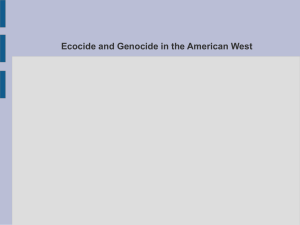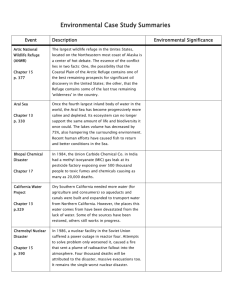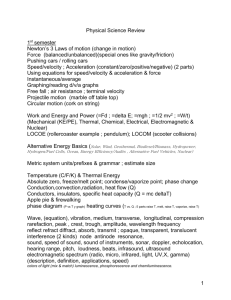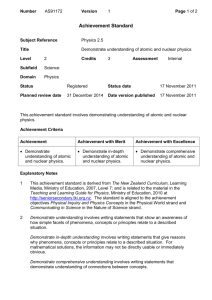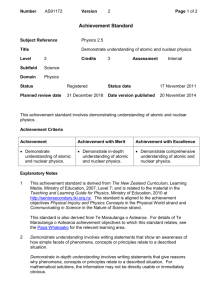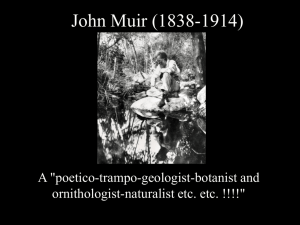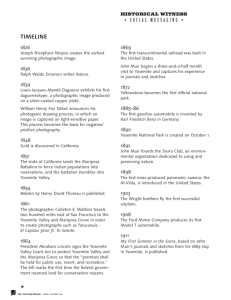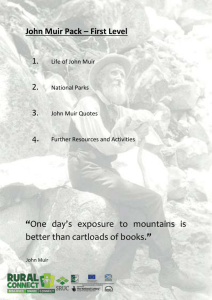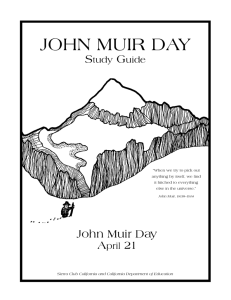ENVIRONMENTAL TIMELINE 1914 1915 1916 1920 1838 1854
advertisement
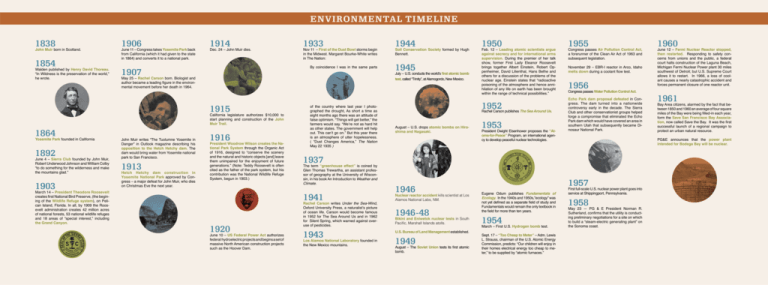
ENVIRONMENTAL TIMELINE 1838 John Muir born in Scotland. 1854 Walden published by Henry David Thoreau. “In Wildness is the preservation of the world,” he wrote. 1906 June 11 – Congress takes Yosemite Park back from California (which it had given to the state in 1864) and converts it to a national park. 1914 Dec. 24 – John Muir dies. 1907 May 25 – Rachel Carson born. Biologist and author became a leading figure in the environmental movement before her death in 1964. 1892 June 4 – Sierra Club founded by John Muir, Robert Underwood Johnson and William Colby “to do something for the wilderness and make the mountains glad.” 1903 March 14 – President Theodore Roosevelt creates first National Bird Preserve, (the begining of the Wildlife Refuge system), on Pelican Island, Florida. In all, by 1909 the Roosevelt administration creates 42 million acres of national forests, 53 national wildlife refuges and 18 areas of “special interest,” including the Grand Canyon. John Muir writes “The Tuolumne Yosemite in Danger” in Outlook magazine describing his opposition to the Hetch Hetchy dam. The dam would bring water from Yosemite national park to San Francisco. 1913 Hetch Hetchy dam construction in Yosemite National Park approved by Congress – a major defeat for John Muir, who dies on Christmas Eve the next year. 1944 Soil Conservation Society formed by Hugh Bennett. 1945 July – U.S. conducts the world’s first atomic bomb test, called “Trinity”, at Alamogordo, New Mexico. California legislature authorizes $10,000 to start planning and construction of the John Muir Trail. Yosemite Park founded in California Nov 11 – First of the Dust Bowl storms begin in the Midwest. Margaret Bourke-White writes in The Nation: By coincidence I was in the same parts 1915 1864 1933 1916 President Woodrow Wilson creates the National Park System through the Organic Act of 1916, designed to “conserve the scenery and the natural and historic objects [and] leave them unimpaired for the enjoyment of future generations.” (Note: Teddy Roosevelt is often cited as the father of the park system, but his contribution was the National Wildlife Refuge System, begun in 1903.) of the country where last year I photographed the drought, As short a time as eight months ago there was an attitude of false optimism. “Things will get better,” the farmers would say. “We’re not as hard hit as other states. The government will help out. This can’t go on.” But this year there is an atmosphere of utter hopelessness. ( “Dust Changes America,” The Nation May 22 1935 ) June 10 – US Federal Power Act authorizes federal hydroelectric projects and begins a set of massive North American construction projects such as the Hoover Dam. Feb. 12 – Leading atomic scientists argue against secrecy and for international arms supervision. During the premier of her talk show, former First Lady Eleanor Roosevelt brings together Albert Einstein, Robert Oppenheimer, David Lilienthal, Hans Bethe and others for a discussion of the problems of the nuclear age. Einstein states that “radioactive poisoning of the atmosphere and hence annihilation of any life on earth has been brought within the range of technical possibilities.” 1952 Rachel Carson publishes The Sea Around Us. August – U.S. drops atomic bombs on Hiroshima and Nagasaki. 1953 President Dwight Eisenhower proposes the “Atoms-for-Peace” Program, an international agency to develop peaceful nuclear technologies. 1955 Congress passes Air Pollution Control Act, a forerunner of the Clean Air Act of 1963 and subsequent legislation. November 29 – EBR-I reactor in Arco, Idaho melts down during a coolant flow test. 1956 Congress passes Water Pollution Control Act. Echo Park dam proposal defeated in Congress. The dam turned into a nationwide controversy early in the decade. The Sierra Club and other conservationist groups helped forge a compromise that eliminated the Echo Park dam which would have covered an area in southern Utah that subsequently became Dinosaur National Park. The term “greenhouse effect” is coined by Glen Thomas Trewartha, an assistant professor of geography at the University of Wisconsin, in his book An Introduction to Weather and Climate. Rachel Carson writes Under the Sea-Wind, Oxford University Press, a naturalist’s picture of ocean life. Carson would become famous in 1952 for The Sea Around Us and in 1962 for Silent Spring, which warned against overuse of pesticides. 1943 Los Alamos National Laboratory founded in the New Mexico mountains. 1946 Nuclear reactor accident kills scientist at Los Alamos National Labs, NM. 1946-48 Bikini and Eniwetok nuclear tests in South Pacific, Marshall Islands atolls. U.S. Bureau of Land Management established. 1949 August – The Soviet Union tests its first atomic bomb. 1957 Eugene Odum publishes Fundamentals of Ecology. In the 1940s and 1950s,”ecology” was not yet defined as a separate field of study and Fundamentals would remain the only textbook in the field for more than ten years. 1954 March – First U.S. Hydrogen bomb test. Sept. 17 – “Too Cheap to Meter” – Adm. Lewis L. Strauss, chairman of the U.S. Atomic Energy Commission, predicts: “Our children will enjoy in their homes electrical energy too cheap to meter,” to be supplied by “atomic furnaces.” 1960 June 12 – Fermi Nuclear Reactor stopped, then restarted. Responding to safety concerns from unions and the public, a federal court halts construction of the Laguna Beach, Michigan Fermi Nuclear Power plant 30 miles southwest of Detroit; but U.S. Supreme Court allows it to restart. In 1966, a loss of coolant causes a nearly catastrophic accident and forces permanent closure of one reactor unit. 1961 Bay Area citizens, alarmed by the fact that between 1850 and 1960 an average of four square miles of the Bay were being filled-in each year, form the Save San Francisco Bay Association, now called Save the Bay. It was the first successful launch of a regional campaign to protect an urban natural resource. PG&E announces that the power plant intended for Bodega Bay will be nuclear. 1937 1941 1920 1950 First full-scale U.S. nuclear power plant goes into service at Shippingport, Pennsylvania. 1958 May 23 — PG & E President Norman R. Sutherland, confirms that the utility is conducting preliminary negotiations for a site on which to build a “steam-electric generating plant” on the Sonoma coast.
